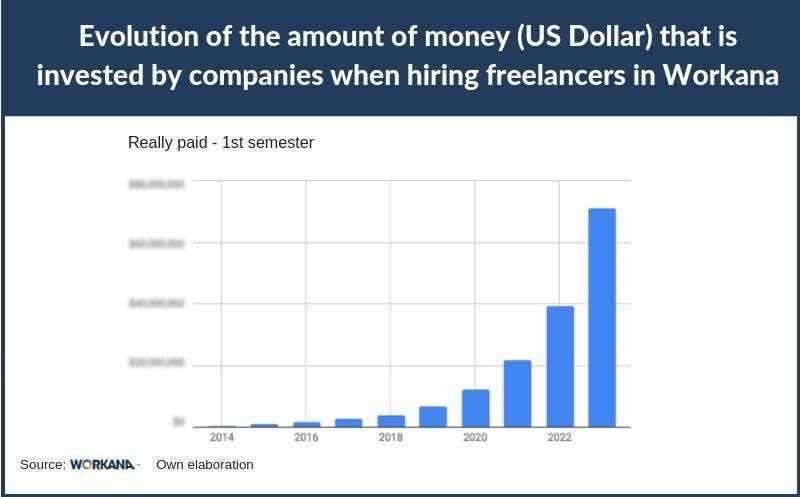Unlocking Your Freelance Potential: A Guide to Growing Your Business
Hey there, fellow freelancer! If you’re reading this, you’re likely already on the exciting journey of freelancing, juggling projects, and chasing deadlines. But let’s be real—working independently is not just about keeping your head above water; it’s about thriving and building a business that reflects your passion and skills. Whether you’re a graphic designer, writer, or digital marketer, you know that the freelance landscape is constantly evolving, and standing out in the crowd can feel like a daunting task.
But what if I told you that growing your freelance business isn’t just possible—it’s within your reach? Imagine consistently landing clients you love, enjoying a steady stream of income, and having the freedom to choose projects that truly inspire you. In this article, we’ll dive into practical strategies and actionable tips that can help you take your freelance business to the next level. From refining your brand to mastering the art of networking, I’ll guide you through the essential steps to not only survive but thrive in the freelance world. So, grab a cup of coffee, and let’s get started on transforming your freelance hustle into a flourishing business!
Understanding Your Niche and Target Audience
To effectively grow your freelance business, it’s crucial to have a deep understanding of your niche and the target audience that resides within it. Knowing your niche allows you to tailor your services, while understanding your audience helps you communicate effectively with them. Start by identifying the specific areas where your skills shine the brightest and where there’s a demand.
Researching Your Niche: Dive into the details of your chosen field by exploring:
- Current trends and demands
- Competitors in the space
- Existing gaps that you can fill
This research can guide you in refining your offerings, ensuring that you provide exactly what your potential clients are looking for. By positioning yourself as an expert in a niche area, you can attract clients who value specialized skills and knowledge.
Defining Your Target Audience: Once you’ve solidified your niche, it’s time to focus on your audience. Ask yourself:
- Who are your ideal clients?
- What challenges do they face that you can solve?
- Where do they typically seek information or services?
Building buyer personas can provide clarity; these personas should represent your ideal clients, detailing their demographics, needs, and preferences. This will help you develop content and marketing strategies that resonate with them. Here’s a simple table to illustrate the elements of an ideal client persona:
| Name | Age | Occupation | Challenges |
|---|---|---|---|
| Sarah | 30 | Marketing Manager | Lack of time for content creation |
| John | 45 | Small Business Owner | Need for effective online presence |
By pinpointing your niche and target audience, you can craft compelling marketing messages and services that speak directly to their needs. Remember, the more you understand the people you want to serve, the better you can connect, engage, and ultimately grow your freelance business.

Crafting an Irresistible Brand Identity
In a crowded market, having a unique brand identity can set you apart from the competition. Your brand is more than just a logo or a color scheme; it’s the essence of who you are as a freelancer. It’s the story you tell, the values you embody, and the emotions you evoke in your clients. To craft an irresistible brand identity, start by defining your unique value proposition. Ask yourself:
- What makes my services distinct?
- Who is my ideal client?
- What emotions do I want my clients to feel?
Once you have a clear understanding of these elements, it’s time to translate them into visual and verbal messaging. Your visual identity should be cohesive across all platforms—from your website to your social media profiles. Consider creating a style guide that includes:
- Color palette
- Typography
- Logo usage
In addition to visuals, your verbal identity is crucial. Develop a consistent tone of voice that resonates with your target audience. Whether it’s friendly and casual or professional and authoritative, ensure that every piece of content reflects this voice. Here’s a quick overview of how different tones can affect perception:
| Tone of Voice | Client Perception |
|---|---|
| Friendly and Casual | Approachable, relatable |
| Professional and Formal | Trustworthy, authoritative |
| Witty and Humorous | Creative, memorable |
don’t underestimate the power of storytelling in building your brand identity. Share your journey, your challenges, and your successes. This not only humanizes your brand but also fosters an emotional connection with your audience. People love to support freelancers who are relatable and authentic. Craft a narrative that encapsulates your passion and commitment, and watch as clients are drawn to your unique brand.

Building an Engaging Online Presence
In today’s digital era, establishing a strong online presence is vital for any freelancer looking to attract clients and grow their business. Your online presence is essentially your digital storefront, and it’s crucial to make it appealing and engaging. Here are some strategies to help you build a captivating online persona.
First, invest time in creating a professional website. Your website should reflect your brand and showcase your skills. Include a portfolio that highlights your best work, as visuals can often speak louder than words. Here are some essential elements to consider:
- About Me Page: Share your story, expertise, and what sets you apart.
- Services Offered: Clearly outline what you offer, along with pricing if possible.
- Contact Information: Make it easy for potential clients to reach you.
Next, leverage social media to connect with your audience and showcase your personality. Platforms like LinkedIn, Instagram, and Twitter can significantly enhance your visibility. Here’s how you can use social media effectively:
- Post Regularly: Share industry insights, personal achievements, or behind-the-scenes looks at your work process.
- Engage with Followers: Respond to comments and messages promptly to build relationships.
- Join Relevant Groups: Participate in discussions and offer your expertise in forums or communities related to your niche.
Another effective way to build your online presence is through content marketing. Start a blog where you can share valuable articles, tips, or case studies related to your field. Regularly updating your blog not only showcases your knowledge but also improves your SEO, driving more traffic to your site. Consider the following topics for your blog:
| Blog Topic Ideas | Purpose |
|---|---|
| Client Success Stories | Builds credibility and showcases your work. |
| Industry Trends | Positions you as an expert and thought leader. |
| How-To Guides | Provides value to your audience and encourages sharing. |
don’t underestimate the power of networking. Attend online webinars, workshops, and industry events to connect with other professionals. Building relationships can lead to referrals and potential collaborations, further expanding your reach. Remember, genuine connections can open doors that you might not even know existed.

Leveraging Social Media for Business Growth
In today’s digital age, social media isn’t just a platform for social interactions; it’s a powerful tool for business expansion. For freelancers looking to amplify their presence, understanding how to effectively utilize these channels can lead to significant growth. Imagine turning casual followers into loyal clients simply by sharing your expertise and engaging with your audience.
Start by identifying which platforms align with your target market. Are you a graphic designer? Visual platforms like Instagram or Pinterest might be your best bet. Writers may find LinkedIn or Twitter more conducive to their needs. Choosing the right social media channels is crucial for maximizing your outreach. Here’s a quick breakdown:
| Platform | Best For | Key Features |
|---|---|---|
| Visual content creators | Stories, posts, highlights | |
| Professionals and B2B | Networking, articles, endorsements | |
| Real-time news and updates | Short posts, hashtags, trending topics |
Once you’ve chosen your platforms, it’s all about building an authentic brand. Share your journey, showcase your work, and don’t shy away from engaging with your audience. Respond to comments, ask questions, and create polls to foster a sense of community around your brand. People are more likely to hire someone they feel they know and trust, so let your personality shine through your posts.
Moreover, consider collaborating with other freelancers or small businesses. Not only does this expand your reach, but it also adds value to your followers. You could host joint webinars, run giveaways, or even feature each other’s work. Cross-promotion is a fantastic way to tap into new audiences without much extra effort.
don’t forget to track your progress. Use analytics tools to monitor engagement rates, follower growth, and the effectiveness of your campaigns. This data will help you refine your strategies and make informed decisions about where to focus your efforts next. The key to success in leveraging social media is to remain adaptable and always be ready to evolve with your audience’s needs.
Networking Like a Pro: Connecting with Potential Clients
Building a network of potential clients is an art that can significantly elevate your freelance career. Start by identifying your target audience and the platforms where they spend their time. Whether it’s social media, industry-specific forums, or local meetups, being present in the right places is crucial. Once you know where to find them, engagement becomes the next step. Don’t hesitate to jump into conversations; share your insights, ask questions, and offer assistance. By positioning yourself as a resource, you naturally draw clients towards you.
Leverage Social Media: Social media is a powerful tool for freelancers looking to connect with clients. Platforms like LinkedIn, Twitter, and even Instagram can help showcase your skills and personality. Here are some tips to enhance your social media presence:
- Share your projects and successes regularly.
- Engage with your followers and respond to comments to build rapport.
- Follow industry leaders and participate in discussions to increase visibility.
Networking is not just about making contact; it’s about cultivating relationships. Attend industry events, workshops, and conferences to meet potential clients face-to-face. When you do meet someone, remember to follow up. A simple email or message expressing gratitude for the conversation can go a long way. To help you remember who to follow up with, consider using a simple table format:
| Name | Contact Method | Follow-Up Date |
|---|---|---|
| Jane Doe | 01/10/2024 | |
| John Smith | 01/15/2024 | |
| Emily Johnson | 01/20/2024 |
don’t underestimate the value of referrals. Happy clients are often your best advocates. Encourage satisfied customers to spread the word about your work. Consider setting up a referral program that incentivizes them to refer others to you. This not only boosts your credibility but also creates a steady stream of potential clients.
Mastering the Art of Effective Pricing Strategies
As a freelancer, understanding how to price your services effectively is crucial to your business growth. It’s not merely about setting a number; it’s about aligning your pricing with the value you provide, your target audience, and market trends. Here’s how you can master this vital aspect of your freelance business.
1. Understand Your Value Proposition:
Before you can set your prices, you need to identify what sets you apart from the competition. Ask yourself:
- What unique skills do I offer?
- How can my expertise solve my clients’ problems?
- What tangible results have I delivered in the past?
By clearly defining your value proposition, you can justify higher rates and attract clients who appreciate quality over quantity.
2. Research the Market:
Take time to analyze what others in your niche are charging. Look for:
- Freelancers with similar skills and experience.
- The range of prices in your industry.
- Common pricing models used (hourly, project-based, retainer).
This research will give you a baseline to work from and help you position your services competitively.
3. Experiment with Pricing Models:
Don’t be afraid to test different pricing strategies to see what resonates with your clients. Consider:
- Hourly rates for smaller projects or consultations.
- Flat fees for well-defined projects to provide clarity.
- Value-based pricing, where you charge based on the results you deliver.
Each model has its advantages, and finding the right fit can significantly impact your profitability.
| Pricing Model | Pros | Cons |
|---|---|---|
| Hourly | Simple to calculate, easy to track hours | Limits income potential, may incentivize longer projects |
| Flat Fee | Clients appreciate clarity, you control scope | Risk of underestimating time or effort |
| Value-Based | Aligns price with results, higher earning potential | Requires strong justification of value |
4. Communicate Your Pricing Confidently:
When discussing your rates with potential clients, confidence is key. Be prepared to:
- Justify your pricing with examples of past successes.
- Explain how your services can benefit them specifically.
- Remain flexible, but avoid undervaluing your work.
Remember, your pricing reflects not just your skills, but the quality of service that clients can expect.

Delivering Exceptional Client Experiences
In the competitive landscape of freelancing, can set you apart from the crowd. It’s not just about completing projects; it’s about creating memorable interactions that keep clients coming back for more. To achieve this, consider focusing on the following key elements:
- Communication: Regularly update your clients on project progress. A quick check-in can reassure them that their investment is in good hands.
- Personalization: Tailor your services to meet the specific needs of each client. This shows that you value their unique requirements and are willing to go the extra mile.
- Timeliness: Delivering work on or ahead of schedule not only impresses clients but also builds trust and reliability.
- Feedback Loop: Encourage clients to provide feedback throughout the project. This fosters an open dialogue that enhances collaboration and satisfaction.
Another effective way to enhance client experience is by implementing a structured onboarding process. This ensures that clients feel welcomed and informed about what to expect. A simple onboarding checklist might include:
| Onboarding Step | Description |
|---|---|
| Initial Consultation | Discuss project goals and gather client preferences. |
| Contract Review | Go through the terms to ensure clarity and mutual understanding. |
| Project Timeline | Outline major milestones and deadlines for transparency. |
| Communication Plan | Set expectations for updates and check-ins. |
don’t underestimate the power of a follow-up after project completion. A simple message expressing gratitude and inviting further collaboration can leave a lasting impression. This small gesture can turn a one-time client into a loyal advocate for your services.
By consistently prioritizing the client experience through effective communication, personalized services, structured onboarding, and post-project follow-ups, you’ll not only grow your freelance business but also build a reputation that attracts new clients. Remember, happy clients are your best marketing tool!
Utilizing Testimonials and Referrals to Boost Credibility
One of the most effective ways to enhance your reputation as a freelancer is by harnessing the power of testimonials and referrals. When potential clients see positive feedback from your previous customers, it builds trust and reduces the perceived risk of hiring you. Consider incorporating testimonials prominently on your website, in your proposals, and on your social media profiles. This strategy not only showcases your skills but also provides social proof that your work delivers results.
To maximize impact, collect testimonials that highlight specific aspects of your work, such as:
- Quality of Work: Positive remarks about the final product.
- Communication Skills: Feedback on how you interact and manage projects.
- Timeliness: Comments about your ability to meet deadlines.
- Problem-Solving: Examples of how you tackled challenges effectively.
Don’t hesitate to ask satisfied clients for referrals. A simple request can go a long way, especially if you’ve built a strong relationship with them. You might say, “If you know anyone who could benefit from my services, I would greatly appreciate your recommendation.” Often, happy clients are more than willing to share your contact information with others in their network.
To further incentivize referrals, consider establishing a referral program. This could involve offering discounts, freebies, or even a commission for each new client they bring in. Here’s a simple table to illustrate how a referral program might work:
| Referral Bonus | Condition |
|---|---|
| $50 Discount | On the next project after a successful referral |
| Free Consultation | For every three referrals |
| 10% Commission | For every new client referred that completes a project |
don’t forget to showcase your accomplishments and testimonials on platforms like LinkedIn or freelance job boards. A well-constructed profile filled with endorsements can significantly enhance your visibility. Engage with your network by sharing success stories, and actively encourage your connections to provide recommendations. By strategically using testimonials and referrals, you’ll not only elevate your credibility but also create a steady flow of new opportunities for your freelance business.

Continuously Upskilling to Stay Competitive
In today’s fast-paced digital landscape, staying relevant is more crucial than ever. As a freelancer, continuously enhancing your skill set not only boosts your marketability but also allows you to adapt and thrive in an ever-evolving environment. Investing time in learning new tools, technologies, and industry trends can set you apart from the competition. Here are some effective strategies to ensure you remain at the forefront of your field:
- Online Courses: Platforms like Coursera, Udemy, and LinkedIn Learning offer a plethora of courses tailored to various skill levels. Whether you’re looking to master a specific software or dive into a new field, there’s something for everyone.
- Networking with Peers: Engaging with fellow freelancers and industry professionals can provide insights into emerging trends and best practices. Attend webinars, join online forums, and participate in local meetups.
- Reading Industry-Related Content: Subscribing to blogs, podcasts, and newsletters can help you stay informed about the latest developments. Consider authors and creators who are thought leaders in your niche.
- Experimenting with Projects: Practical experience is invaluable. Take on new projects that challenge your current skills or allow you to explore a different area of expertise.
Moreover, establishing a personal development plan can guide your learning journey. A simple table can help you track your progress and identify which skills you want to develop further:
| Skill | Learning Method | Target Completion Date |
|---|---|---|
| Web Development | Online Course | June 2024 |
| Graphic Design | Workshops | August 2024 |
| SEO Optimization | Reading & Practice | October 2024 |
Remember, continuous upskilling isn’t just about acquiring knowledge; it’s about applying what you learn to your freelance business. Whether you pivot to a new niche or refine your current services, the more versatile you are, the more opportunities you’ll attract. Embrace the journey of learning as a fundamental part of your freelance career, and watch your business flourish!
Frequently Asked Questions (FAQ)
Q&A: How to Grow Your Freelance Business
Q1: What are the first steps I should take to grow my freelance business?
A: Great question! The first step is to clearly define your niche. What skills do you excel at, and who needs them? Once you have a clear target audience, focus on building a strong online presence. Create a professional website showcasing your portfolio, and don’t underestimate the power of social media. Platforms like LinkedIn, Instagram, or even TikTok can help you connect with potential clients and showcase your work.
Q2: How important is networking for freelancers?
A: Networking is crucial! Think of it as the lifeblood of your freelance business. Attend industry events, join online communities, and engage in conversations on social media. You never know where your next big project might come from. Remember, people are much more likely to hire you if they know you, like you, and trust you. So, get out there and start building those relationships!
Q3: What strategies can I use to attract more clients?
A: Attracting clients is all about visibility and value. Regularly update your portfolio with your latest work, write helpful blog posts related to your field, and consider offering free resources or consultations to showcase your expertise. Don’t forget to ask satisfied clients for testimonials and referrals! Social proof can significantly influence potential clients’ decisions.
Q4: Should I consider joining freelance platforms?
A: Absolutely! Freelance platforms like Upwork, Fiverr, or Freelancer can be fantastic for gaining initial clients and building your reputation. They help you reach a broader audience and can provide a steady stream of work, especially when you’re just starting out. Just remember to select jobs that align with your skills and values to maintain quality.
Q5: How can I ensure I’m charging what I’m worth?
A: This is a common concern among freelancers! Start by researching industry standards for your services and experience level. Don’t undervalue your skills; remember that your time and expertise are valuable. Consider your expenses, and don’t hesitate to increase your rates as you gain more experience and positive feedback. Be confident in your worth, and clients will appreciate the value you bring to the table.
Q6: What if I’m struggling to manage my workload?
A: Managing your workload effectively is key to sustaining growth. Employ tools like project management software, and don’t hesitate to set boundaries. Learn to say no to projects that don’t fit your goals or overwhelm you. Additionally, consider collaborating with other freelancers or even outsourcing tasks that take too much of your time but don’t directly benefit your clients.
Q7: How can I keep my skills sharp and stay competitive?
A: Continuous learning is essential in the freelance world. Invest in online courses, attend webinars, and read industry-related books. Follow trends and innovations in your field to ensure you stay relevant. Your clients will appreciate your updated skills, and it will enhance your credibility in the marketplace.
Q8: What’s the best piece of advice for sustaining long-term growth?
A: Focus on building relationships over transactions. Treat your clients like partners and invest time in understanding their needs. Regularly check in with them even after a project is completed. Happy clients lead to repeat business and referrals, which are vital for long-term growth. Always strive for excellence in your work, and the rest will follow.
Q9: How do I handle setbacks or challenges in my freelance journey?
A: Setbacks are a natural part of any business journey, including freelancing. When challenges arise, take a step back and analyze what you can learn from the situation. Stay resilient and adaptable—these traits will serve you well. Surround yourself with a supportive network of fellow freelancers or mentors who can provide guidance and encouragement during tough times.
Q10: Can I really grow my freelance business into something substantial?
A: Absolutely! Many freelancers have turned their side gigs into thriving businesses. With persistence, strategic planning, and continuous self-improvement, you can achieve your goals. Remember, every big success starts with small steps. Stay focused, keep hustling, and trust the process. Your freelance dream can absolutely become a reality!
To Wrap It Up
As we wrap up this guide on growing your freelance business, remember that success doesn’t happen overnight. It’s a journey filled with learning, adaptation, and perseverance. By implementing the strategies we’ve discussed—whether it’s honing your skills, networking, or effectively managing your time—you’re already setting yourself up for success.
Think of your freelance career as a garden. With the right care, attention, and a sprinkle of creativity, you can cultivate a flourishing business that not only meets your financial goals but also gives you the freedom and flexibility you crave. So, take a deep breath, embrace the challenges, and celebrate the small wins along the way.
Now is the perfect time to put these tips into action. Start small, be consistent, and watch your efforts blossom. Don’t hesitate to reach out to fellow freelancers, mentors, or communities for support and inspiration. You’re not alone in this—many have walked this path before you and are eager to help.
So, are you ready to take your freelance business to new heights? The possibilities are endless! Dive in, stay committed, and let your passion guide you. Your dream freelance life is within reach—go out there and make it happen!

